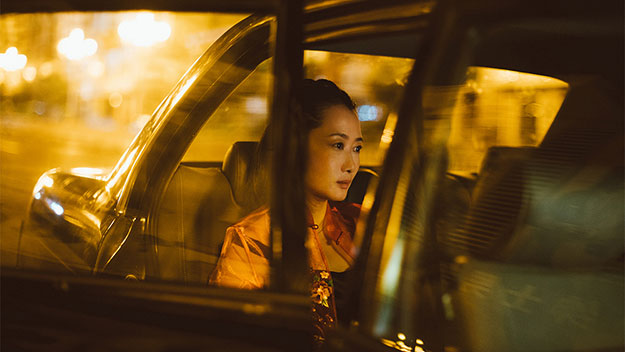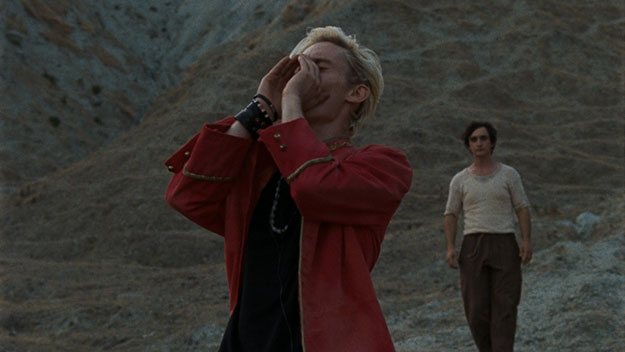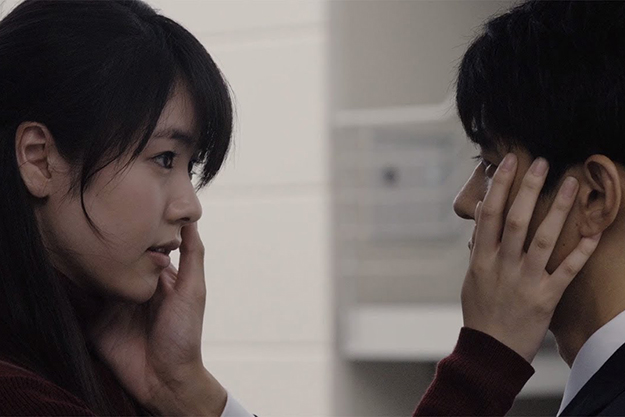Ash Is Purest White When a filmmaker is accused of repeating himself—and especially when that charge is leveled within the attention-deficient atmosphere of Cannes—there’s a good chance the accusers just aren’t watching closely enough. Case in point: Jia Zhangke’s stirring Competition entry, Ash Is Purest White, unrewarded by the jury and dismissed by some as simply more of the same. Since his debut feature, Xiao Wu (1997), the tale of a small-town pickpocket struggling to adapt to the new black-market economy, Jia’s extraordinary body of work has doubled as a record of 21st-century China and its warp-speed transformations, assuming the role of witness and at times of critic and conscience. His recent experiments with genre can be read as an implicit acknowledgment of the limits of social realism. If 2013’s A Touch of Sin flirted with the wuxia (martial arts) form, Ash Is Purest White—as implied by its Chinese title, which translates as Sons and Daughters of Jianghu—embraces its jianghu, or criminal underworld, setting, where age-old codes of conduct are hardly exempt from the modernizing tides of contemporary China. Strictly speaking, though, Ash is less a gangster movie than a melodrama, a genre that perfectly fits Jia’s interest in time and what it does to people, his knack for showing how abstract forces shape individual lives. The film opens in 2001, amid the gambling dens and nightclubs of post-industrial Datong, where Qiao (Zhao Tao) and her mobster boyfriend Bin (Liao Fan) are staking out their turf against rivals and upstarts. The milieu is familiar from Jia’s Unknown Pleasures (2002), and the déjà vu turns out to be part of a sly strategy. The first section concludes with an act of self-sacrifice that lands Qiao in prison for five years. Upon release she embarks on a pilgrimage in search of Bin that takes her past the soon-to-be-flooded towns at the Three Gorges Dam, the metaphorically charged setting of Jia’s Still Life (2006). Throughout Ash, characters can be found reveling in the pleasures of newly imported pop culture, from ballroom dancing to disco to Hong Kong movies, as they do in Jia’s early films, most of all his era-defining masterpiece Platform (2000). (A few other Cannes titles functioned as semi-musicals, including Pawel Pawlikowski’s Cold War, which journeys from Polish folk to Parisian jazz, and Kirill Serebrennikov’s Leto, a paean to the pre-glasnost heyday of Russian rock and roll. But Jia’s way of capturing the Proustian tug of a pop refrain—whether the Village People’s “Y.M.C.A.” or Sally Yeh’s theme song from The Killer—is unparalleled.) As in his previous feature, Mountains May Depart (2015), Jia portrays the passage of time through narrative ellipses and a three-part structure. But if Mountains sought new horizons, extrapolating through time and space into a near-future Australia, the movement here is circular, bringing its principal characters back to present-day Datong to emotionally devastating effect. Ash Is Purest White is a self-conscious acknowledgment that Jia’s career to date corresponds with a period of unprecedented change in Chinese life. He revisits the sites and situations of his earlier work not for lack of inspiration or out of self-regard but specifically to find a new vantage on them. We know Jia’s films as state-of-the-nation dispatches, and the shift here to the backward glance, the past tense—even if it is the very recent past—allows for more rueful registers and more complicated tones to emerge. Ash Is Purest White is a tragicomedy in the fullest sense, at once his funniest and saddest film, and in the formidable, quick-witted Qiao, a paragon of resilience and resourcefulness, Zhao Tao (never better) has fashioned a heroine for the ages.
Happy as Lazzaro What Jia does with his own filmography—recombine aspects of it with singular results—Alice Rohrwacher seems to do with a dizzyingly wide swath of Italian cinema in her third and most ambitious feature, Happy as Lazzaro. (It shared the screenplay prize with Jafar Panahi’s moving Kiarostami homage 3 Faces.) Throwing in its lot with the Italian underclass, this beguiling shape-shifter summons the spirit of Pasolini, while also nodding to Ermanno Olmi and the Tavianis as well as the folkloric gestures of Rohrwacher’s contemporaries Pietro Marcello and Alessandro Comodin, who have shrewdly explored the overlap of documentary and myth. For its first half, the style of the film is familiar from Rohrwacher’s Corpo Celeste (2011) and The Wonders (2014): an alert, loose-limbed naturalism that favors poetic reduction and partial glimpses, leaving ample room for mystery. We find ourselves amid a throng of tobacco farmers, perhaps an extended clan, living in a state of extreme deprivation. One of the teenagers—the kind, wide-eyed Lazzaro (non-pro Adriano Tardiolo, quite a find)—emerges as a focal point; looming off to the side is the threatening figure of the marchesa (Nicoletta Braschi) who rules the estate known as Inviolata. For an impressively sustained duration, it is not at all clear when this is taking place, and the warm grain of Hélène Louvart’s 16mm cinematography adds to the out-of-time quality. The peasant garb and feudal conditions suggest a bygone era. But a few temporal markers—including the arrival of the marchesa’s son, Tancredi, with his Walkman and New Wave outfits—gradually signal that this tale of grotesque exploitation (based on an actual case) is transpiring in the not too distant past. In her previous work, Rohrwacher has allowed for the possibility of the everyday miracle, connecting eruptions of the unreal to the magical thinking of adolescence. Happy as Lazzaro hinges on a much riskier gambit, a stunning mid-movie leap that vaults the narrative squarely into the present day and into the realm of parable. Decades later, the former sharecroppers, freed from the clutches of the marchesa, are barely subsisting on the fringes of urban society. And Lazzaro, who had apparently suffered a fatal fall back at Inviolata, materializes into this new, very recognizable hell of inequity not just alive but completely unchanged—resurrected, one might say. In a fable with both Christian and Marxist overtones, Rohrwacher keeps the spell alive even as she sharpens her political stance.
In My Room A rather more deadpan confluence of realism and fabulism could be found in another festival highlight, In My Room, the fourth feature by the German director Ulrich Köhler that premiered in the Un Certain Regard section. Inspired by post-apocalyptic novels of ideas like Arno Schmidt’s Black Mirrors and Marlen Haushofer’s The Wall, Köhler takes a disarmingly realistic and restrained approach to a fantastical premise: the eternally popular fantasy of the last man on earth. Indeed the catastrophic event itself—deferred until a third of the way into the film—happens off screen and is never explained. Köhler instead opens by establishing the desultory existence of sad-sack, 40ish TV cameraman Armin (Hans Löw). Summoned home by his father to help tend to Armin’s terminally ill grandmother—the death-bed scenes are patient, unflinching, tender—he wakes one morning to find the world around him entirely depopulated. Köhler’s previous films—Bungalow (2002), Windows on Monday (2006), Sleeping Sickness (2011)—all deal in some way with disappearances and withdrawals from the world, with questions of home and belonging; the various types of estrangement in his work reach a culminating point here with a protagonist confronting an ultimate form of alienation, literally alone on this planet. After a second act in which Armin achieves a state of self-sufficiency (Löw’s physical transformation and animal-wrangling skills are notable), the film introduces an Eve (Elena Radonicich’s headstrong fellow survivor Kirsi) to complicate the apparent contentment of its Adam. The last man is also, of course, the first man. A film of meticulous details and sly, subtle ironies, In My Room infuses its high concept with a touching spirit of genuine inquiry. Its central scenario is by now exceedingly familiar from science fiction and pop culture, but it takes a director of Köhler’s skills and temperament to maximize its potential as a philosophical thought experiment.
Asako I & II Another newcomer to Cannes who plainly delighted in bending the rules of his chosen genre, Ryusuke Hamaguchi delivered the most curious film in this year’s competition with Asako I & II, an authentically mysterious object.Based on a novel by Tomoka Shibasaki, the film traces the trajectory of a love—or, to be accurate, two loves—found, lost, displaced, and regained. The narrative is fairly routine in outline but peculiar at almost every stage of the telling. The first set of lovers, Asako (Erika Karata) and Baku (Masahiro Higashide), meet right off the bat in overblown movie-romance manner, locking eyes and lips as fireworks go off—although a sneaky cut reveals that this is actually their version of events, as recounted to friends. Their relationship is intense, all-consuming, especially for Asako, but one day the moody Baku ups and vanishes. Two years later, having moved from Osaka to Tokyo, Asako meets Baku’s exact double, an even-keeled sake marketing executive named Ryuhei (also played by Higashide), a bizarre coincidence that allows the film to toy, in ways both playful and profound, with the romance genre’s laws of attraction. Hamaguchi gained plenty of cinephile attention for his five-hour-plus Happy Hour (2015), an immersive exploration of female friendship and midlife awakening, and Asako I & II shares with that film an interest in the performative dimension of daily life and an abiding belief that even the most mundane moments are charged with possibility. Apart from the visible doubles—the dual male protagonists—there also seem to be, as the title declares, two versions of Asako, depending on the given object of desire. Asako and Baku meet outside a photo exhibit by Shigeo Gocho titled “Self and Others,” and in Asako I & II, obsessive love is nothing less than a threat to the self. To its great credit, this is not an easy film to get a fix on—its default tone is off-kilter, tilting at times toward the uncanny and eerie. What does eventually become clear is that Hamaguchi’s film is a truly original riff on the doppelgänger touchstone that is Vertigo, an enchanting, unnerving paean to the notion of love as a trance state. Dennis Lim is the director of programming at the Film Society of Lincoln Center.



